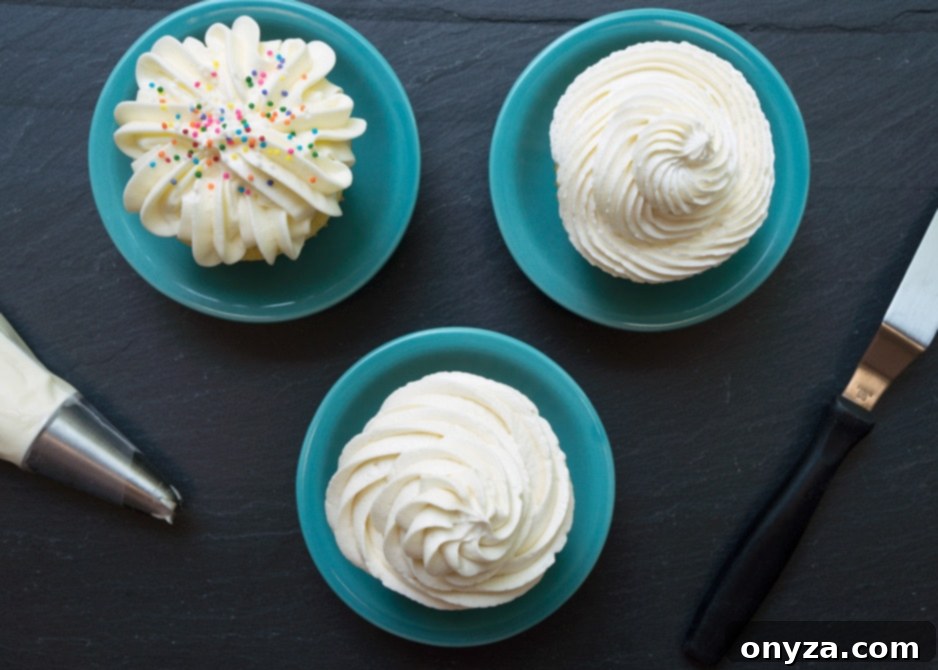Welcome to the delightful world of vanilla frostings! Here, we explore three of my absolute favorites: Ermine (Boiled Milk) Icing, American Buttercream, and Swiss Meringue Buttercream. Each offers a unique texture and flavor profile, ensuring there’s a perfect match for every cake and occasion.
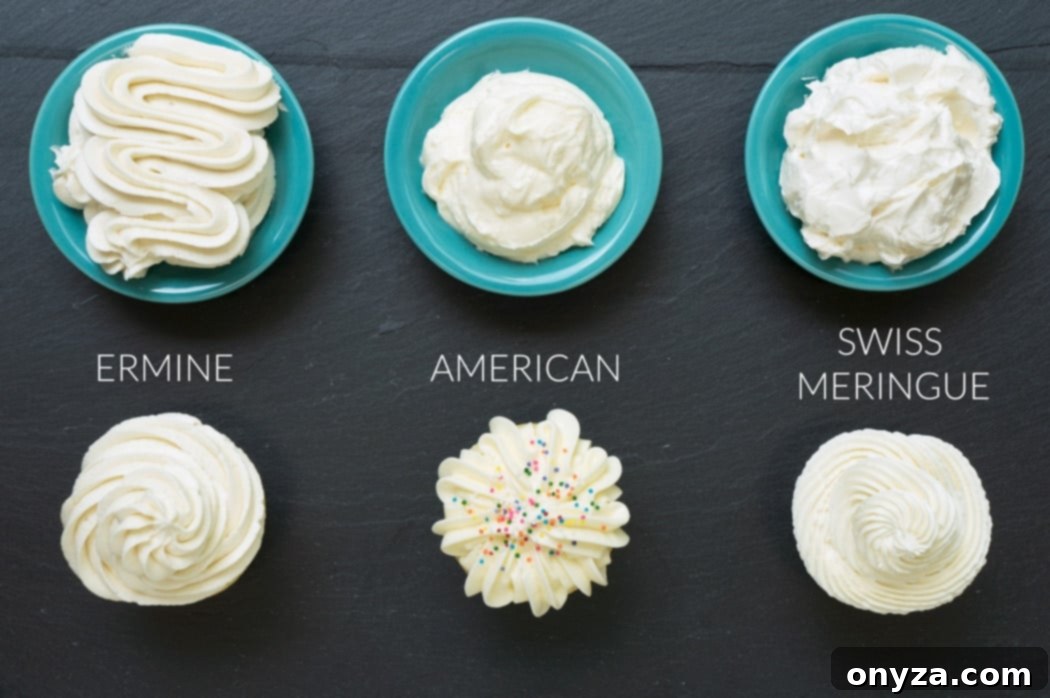
My Journey into Cake and Cupcake Decorating
My passion for cake and cupcake decorating began at a young age, sparked by a yearning for a specific Christmas gift. Around the age of 13, the top item on my Christmas wishlist wasn’t a toy or the latest gadget, but rather the coveted “Martha by Mail” Cake Decorating Kit. I’d stumbled upon an advertisement for it in one of my mother’s issues of Living magazine, and instantly, visions of beautifully adorned cakes danced in my head.
The kit promised a treasure trove of fifty-two essential pieces for cake decorating, all meticulously organized in a shiny storage box. It included everything a budding baker could dream of: professional-grade pastry bags, a versatile Ateco tip set for intricate designs, rose nails for crafting delicate sugar flowers, vibrant gel food colorings, and essential spreading spatulas. My heart genuinely fluttered at the thought of owning such a comprehensive set.

While I harbored grand visions of replicating the glorious, picture-perfect cakes from the magazine pages, my very first attempt that year was, to put it mildly, a disaster. The cake layers were noticeably lopsided, my carefully piped flowers sagged with a disheartening droop, and the pristine vanilla frosting became riddled with unsightly chocolate crumbs. It was a humbling lesson, revealing that “crumb coats” are, in fact, incredibly important. We live and learn, especially in the kitchen!
Despite that initial setback, the allure of cake decorating never faded. Several decades later, that very same Martha by Mail kit is still going strong, a testament to its quality and my enduring enthusiasm. I seize any excuse I can find to pull out a pastry bag, transforming simple batters into edible works of art. The journey from novice to confident decorator has been a delightful one, marked by countless hours of practice, experimentation, and, of course, delicious results.
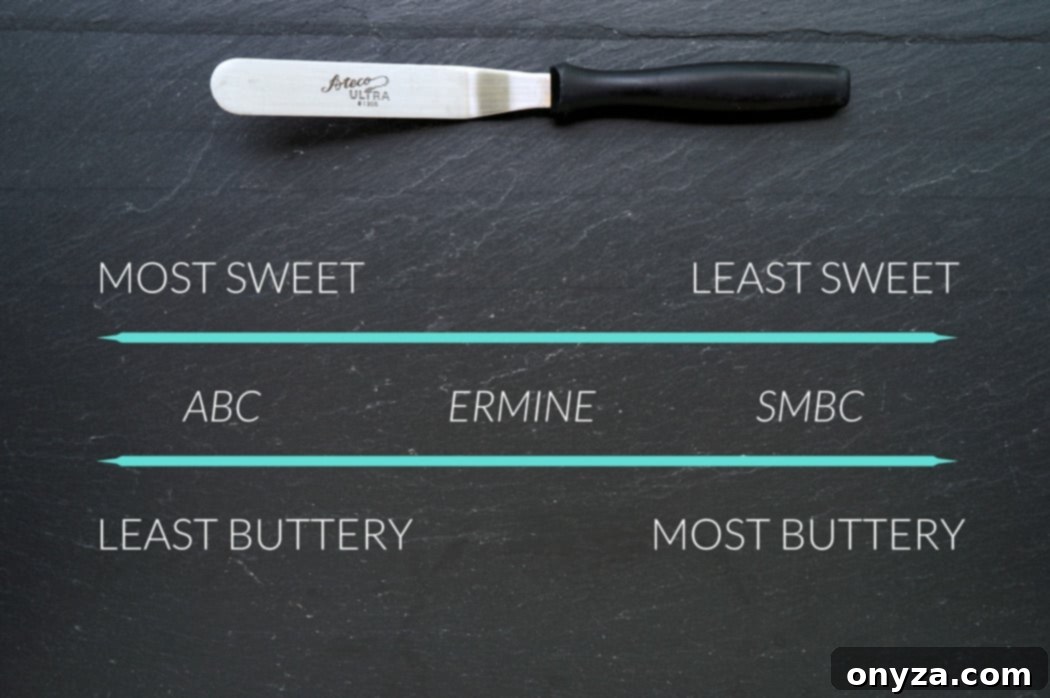
Beyond teaching me an array of piping techniques and the importance of structural integrity in cakes, that kit also introduced me to the wonderful and diverse world of buttercream. Over the years, I’ve tried countless recipes in search of that elusive “perfect” dyeable vanilla frosting, one that would beautifully top my cakes and cupcakes. Friends and family often ask me to share my most beloved recipes, a request I happily fulfill.
Rather than settling on a single ultimate vanilla frosting recipe, I’ve come to embrace three distinct varieties that I use in rotation. My choice depends entirely on the specific type of cake I’m decorating, the desired aesthetic, and the preferences of the guests I’m serving. These tried-and-true favorites are American Buttercream, Swiss Meringue Buttercream, and the classic Ermine Icing. Each offers unique characteristics that make them stand out, providing a versatile arsenal for any baking project.
Understanding Vanilla Frostings: A Comparative Guide
Choosing the right vanilla frosting can elevate a simple cake or cupcake into something truly extraordinary. The “perfect” frosting isn’t a one-size-fits-all solution; it depends on various factors such as desired sweetness, texture, stability, and ease of preparation. Let’s delve into the nuances of my three go-to vanilla frostings, exploring what makes each one special and when to choose it.
American Buttercream (ABC): The Sweet Classic
American Buttercream, often abbreviated as ABC, holds a special place in my baking history. It was the very first frosting I ever learned to make, way back when I was enthusiastically churning out miniature cakes from my lightbulb-powered Easy Bake Oven (feeling like a true culinary boss, I might add!). This simple yet versatile frosting remains a staple for many home bakers and professional decorators alike.
At its core, ABC is a straightforward mixture of softened butter (or sometimes shortening for added stability and a whiter finish), a generous amount of confectioner’s sugar, and a splash of milk or cream to achieve the desired consistency. Its simplicity is one of its greatest assets; it’s incredibly forgiving and quick to prepare, making it a fantastic choice for last-minute baking projects. The process typically involves creaming the butter until light and fluffy, gradually adding the powdered sugar, and then mixing in the liquid and vanilla extract until smooth.
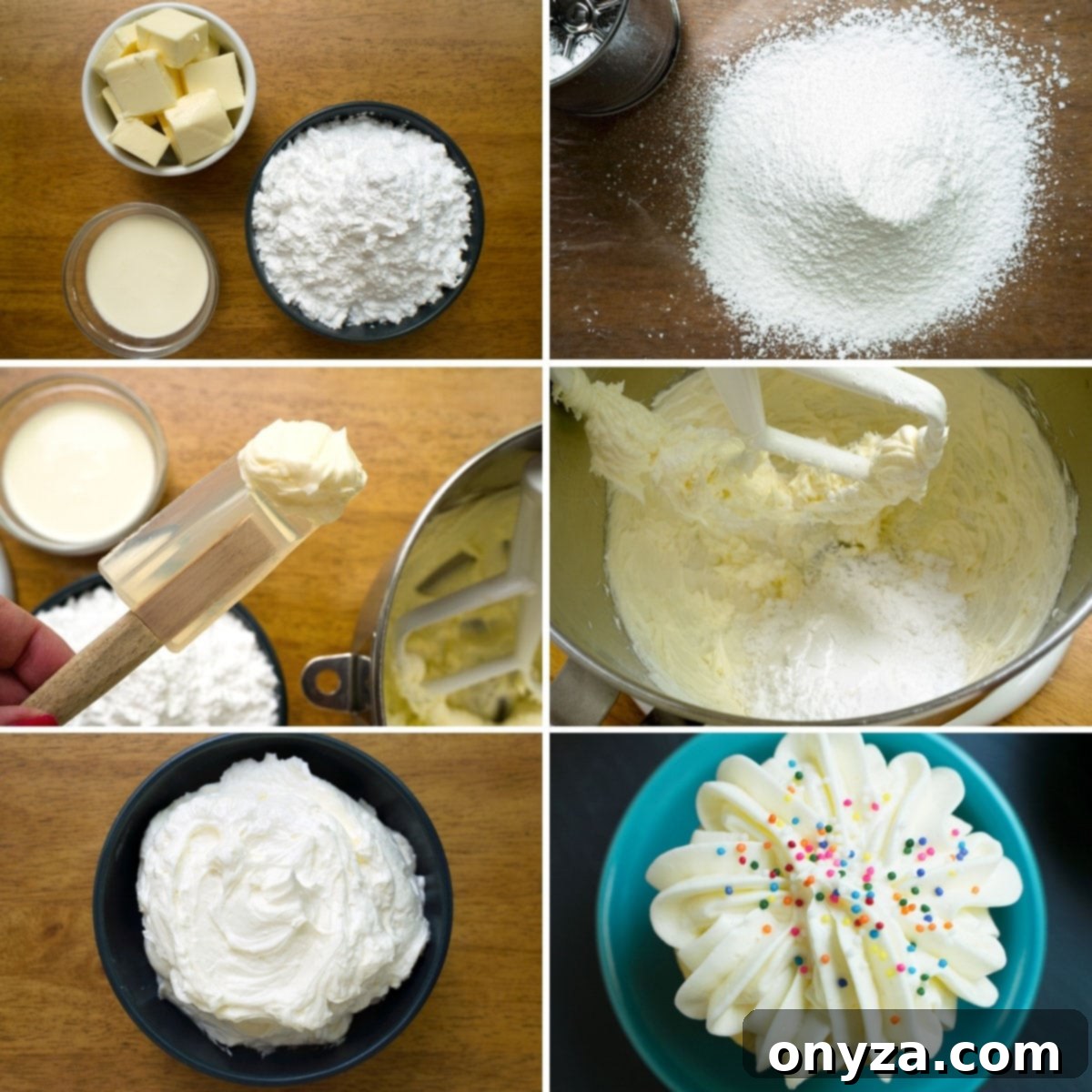
One of the significant advantages of American Buttercream is its excellent piping capabilities. It holds its shape beautifully, making it ideal for creating intricate designs, borders, and rose swirls on cakes and cupcakes. It also keeps well at room temperature for several days, and even longer when refrigerated, proving to be a convenient option for make-ahead desserts. Its sturdy texture makes it perfect for filling and crumb coating layered cakes, providing a stable foundation for further decoration.
However, if I have one minor reservation about ABC, it’s often its sweetness level. For my personal taste, a little bit of this frosting goes a long way, especially when paired with an already sweet cake. This intense sweetness comes from the high proportion of powdered sugar. Additionally, since it’s an uncooked frosting and relies heavily on powdered sugar, the mouthfeel can sometimes be a bit less smooth and occasionally slightly grainy compared to other buttercreams. (Though, I’ve found that the texture often improves significantly after refrigerating the frosting and allowing it to return to room temperature on the second day, as the sugar crystals have more time to dissolve and meld.)
Despite these minor drawbacks, ABC remains a classic and an essential addition to any cake-decorating recipe arsenal. Its vibrant color absorption also makes it perfect for achieving bold hues. Moreover, it’s a frosting that kids tend to absolutely adore, making it a reliable choice for children’s parties and family gatherings. For a quick, dependable, and visually striking frosting, American Buttercream is often the go-to.
Swiss Meringue Buttercream (SMBC): The Silken Dream
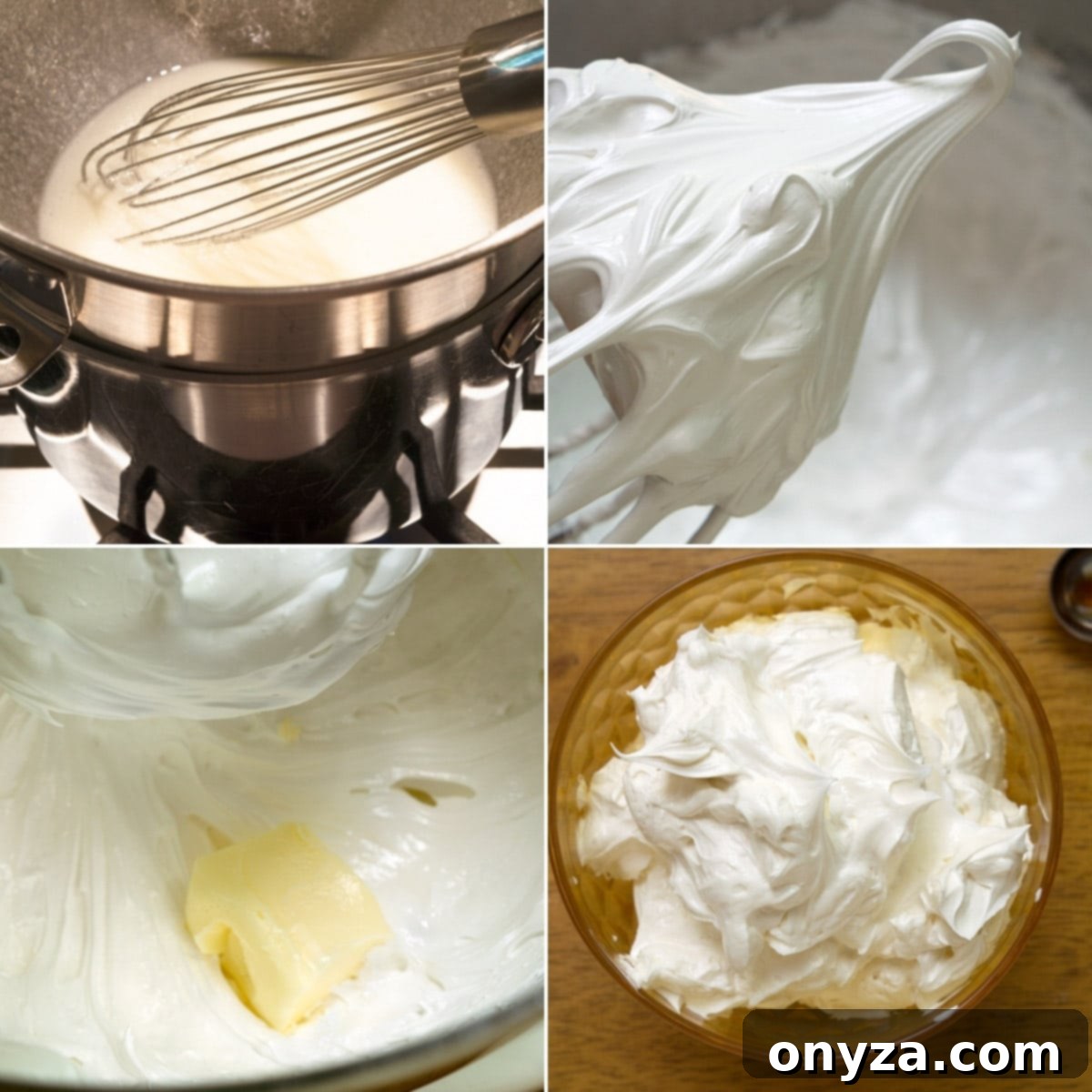
Stepping into the realm of more sophisticated frostings, we encounter Swiss Meringue Buttercream (SMBC). This frosting is truly a showstopper, renowned for its luxuriously smooth, almost silken texture and intensely buttery flavor that is perfectly balanced without being overly sweet. It’s a favorite among professional bakers and those seeking a more refined finish for their desserts.
The creation of SMBC involves a slightly more intricate process than American Buttercream, but the results are undeniably worth the effort. It begins by gently heating egg whites and granulated sugar over a double boiler, continuously whisking until the sugar is fully dissolved and the mixture reaches a safe temperature (typically around 160°F or 71°C). This crucial step pasteurizes the egg whites and creates a stable meringue base. Once heated, this mixture is then whipped vigorously until it transforms into glossy, stiff peaks and cools completely. Only then is softened butter gradually beaten in, piece by piece, until the mixture emulsifies into a smooth, cloud-like buttercream. This method ensures a stable, satiny frosting that’s a delight to work with.
The primary advantages of SMBC are its exceptional texture and stability. Its incredible smoothness makes it perfect for achieving flawlessly frosted cakes, providing a sophisticated look. It’s also significantly less sweet than American Buttercream, allowing the true flavors of the cake and other fillings to shine through. Furthermore, SMBC is remarkably stable, especially in warmer climates, holding its shape beautifully without wilting. This makes it an excellent choice for outdoor events or desserts that need to sit out for a while.
Given its rich yet balanced profile, I find SMBC pairs best with sponge cakes, light-crumbed cupcakes, and delicate pastries. Its refined flavor complements rather than overpowers, making it ideal for elegant layered cakes and decorative work where precision is key. While it requires a bit more time and attention to detail, the superior taste and texture of Swiss Meringue Buttercream make it a truly rewarding choice for any serious baker.
Ermine Icing (Boiled Milk Vanilla Frosting): The Goldilocks Frosting

If there ever was a “Goldilocks” moment in my extensive journey of testing frosting recipes, then Ermine Icing (also widely known as “Roux Frosting,” “Boiled Milk Frosting,” or “Flour Buttercream”) could undoubtedly be described as “just right.” This unique and often underestimated frosting strikes a beautiful balance between the sweetness of ABC and the richness of SMBC, offering a truly distinctive experience.
Ermine Icing boasts a fascinating preparation method that sets it apart. It begins by cooking a simple flour and milk paste on the stovetop, stirring constantly until it thickens into a pudding-like consistency. This cooked roux is then allowed to cool completely, often to room temperature. Once cooled, this flour-milk paste is gradually whipped into softened butter and granulated sugar, transforming into a remarkably light, fluffy, and incredibly smooth frosting. The process might sound unusual to those accustomed to traditional buttercreams, but it yields an exceptionally stable and delicious result.
The characteristics of Ermine Icing are truly delightful. It is lightly sweet, a welcome change for those who find traditional buttercreams overly sugary. Its texture is wonderfully fluffy, often reminiscent of a delicate whipped cream, yet it holds its shape far better. This ethereal quality makes it incredibly palatable and less heavy on the palate. Historically, before cream cheese frosting became the ubiquitous choice for Red Velvet Cake, Ermine Icing was the traditional and preferred frosting. Its subtle sweetness and velvety texture were considered the perfect counterpoint to the cake’s cocoa notes.
Today, Ermine Icing has become my absolute “go-to” frosting for most cupcakes. Its light and airy nature complements almost any cupcake flavor without being overwhelming. It pipes beautifully, creating elegant swirls and decor, and maintains its lovely texture. I absolutely love it for its unique qualities and its ability to deliver a satisfying sweetness without being cloying. If you haven’t tried Ermine Icing, it’s a must-add to your baking repertoire, especially if you’re seeking a frosting that is both classic and wonderfully distinct.

Buttercream Takeaways: Tips for Perfect Frosting and Joyful Decorating
Through all my years of baking and decorating, there’s one invaluable lesson I’ve learned about cakes and cupcakes (aside from the absolute necessity of a proper crumb coat, of course): it’s crucial to have fun and truly enjoy the process. Baking and decorating should be a joyous, creative outlet, not a source of stress. Your creation will still be incredibly delicious, and your friends and family will undoubtedly cherish it, even if your decorations don’t quite match the magazine-perfect images you envision.
There’s something uniquely special and incredibly heartwarming about serving a hand-decorated cake or batch of cupcakes, made with love and personal effort. This personal touch more than makes up for any small imperfections or less-than-flawless piping. The joy of sharing a homemade treat is unmatched. Not to mention, there’s the added, delightful perk of being able to sneak a taste of the leftover frosting directly from the beater attachments when you’re done. Go ahead, indulge a little – your secret’s safe with me!
General Tips for Frosting Success:
- Quality Ingredients Matter: Always start with good quality butter, fresh eggs (for meringue-based frostings), and pure vanilla extract. These foundational ingredients directly impact the final flavor and texture.
- Temperature is Key: Ensure your butter is at the correct temperature (usually softened but still cool for most buttercreams). For meringue buttercreams, make sure the meringue is completely cooled before adding butter to prevent a soupy mess.
- Sift Powdered Sugar: For American Buttercream, sifting your confectioner’s sugar can significantly reduce grittiness, leading to a smoother frosting.
- Patience, My Friend: Don’t rush the mixing process. Allow butter to cream properly, meringue to whip to stiff peaks, and ingredients to fully emulsify.
- Scrape Down the Bowl: Regularly scrape down the sides and bottom of your mixing bowl to ensure all ingredients are incorporated evenly.
- Adjust Consistency: Keep a little extra milk/cream (for ABC) or powdered sugar (for ABC if too thin) or even a tiny bit of meringue (for SMBC if too thick) on hand to adjust the consistency as needed for piping or spreading.
- Store Properly: Most buttercreams can be made ahead and stored. Always cover them tightly. They will need to be re-whipped to achieve their original fluffy consistency after refrigeration.
Embrace the adventure of baking and decorating. Experiment with these three fantastic vanilla frosting recipes, find your favorites, and most importantly, enjoy every delicious moment!
Vanilla Frosting Recipes
Ready to try your hand at these versatile and delicious vanilla frostings? Click on the links below to find detailed recipes and step-by-step instructions for each:
- American Buttercream
- Swiss Meringue Buttercream
- Ermine (Boiled Milk) Icing
Happy baking!
